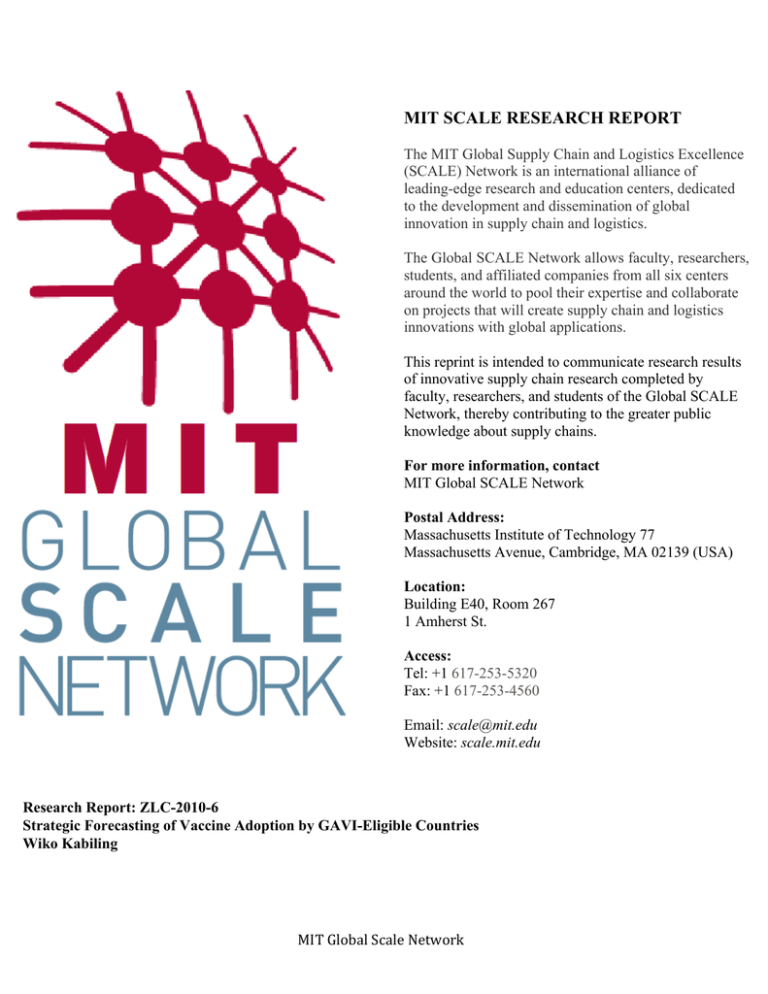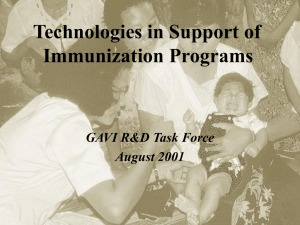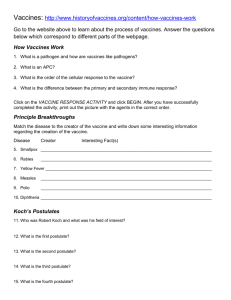MIT SCALE RESEARCH REPORT
advertisement

MIT SCALE RESEARCH REPORT The MIT Global Supply Chain and Logistics Excellence (SCALE) Network is an international alliance of leading-edge research and education centers, dedicated to the development and dissemination of global innovation in supply chain and logistics. The Global SCALE Network allows faculty, researchers, students, and affiliated companies from all six centers around the world to pool their expertise and collaborate on projects that will create supply chain and logistics innovations with global applications. This reprint is intended to communicate research results of innovative supply chain research completed by faculty, researchers, and students of the Global SCALE Network, thereby contributing to the greater public knowledge about supply chains. For more information, contact MIT Global SCALE Network Postal Address: Massachusetts Institute of Technology 77 Massachusetts Avenue, Cambridge, MA 02139 (USA) Location: Building E40, Room 267 1 Amherst St. Access: Tel: +1 617-253-5320 Fax: +1 617-253-4560 Email: scale@mit.edu Website: scale.mit.edu Research Report: ZLC-2010-6 Strategic Forecasting of Vaccine Adoption by GAVI-Eligible Countries Wiko Kabiling MITGlobalScaleNetwork For Full Thesis Version Please Contact: Marta Romero ZLOG Director Zaragoza Logistics Center (ZLC) Edificio Náyade 5, C/Bari 55 – PLAZA 50197 Zaragoza, SPAIN Email: mromero@zlc.edu.es Telephone: +34 976 077 605 MITGlobalScaleNetwork Strategic Forecasting of Vaccine Adoption by GAVI-Eligible Countries By Wiko Kabiling Thesis Advisor: Dr. Laura Rock Kopczak Summary: This thesis investigates the factors that affect the adoption of vaccines by low-income countries into their national immunization programs, particularly in an emerging environment where countries have to choose among many available vaccines. The thesis proposes a rule-based model that uses public data to forecast adoption over a 20-year horizon and uses a sample forecast to quantify future adoption delays. Master of Engineering in Supply Chain and Logistics, MIT-Zaragoza International Logistics Program, Zaragoza Logistics Center, Spain Analytics Consultant at Davies Consulting Master/Bachelor of Science, Industrial Engineering, De La Salle University – Manila, Philippines Introduction A new environment for vaccines is emerging. Vaccines are one of the most cost-effective public health interventions and are critical to meeting the United Nations Millennium Development Goal of reducing deaths among children less than five years old. In the past decade, the rate at which new vaccines have been introduced into the world market has been unprecedented (see Figure 1). The pipeline of vaccine development addresses some of the biggest causes of child mortality, including malaria (WHO, UNICEF, World Bank, 2009). Furthermore, funding for the adoption of such vaccines by low-income countries is made available by the GAVI Alliance, a public-private partnership that co-finances the purchase of a set of prequalified vaccines by countries deemed eligible based on socio-economic status. However, given the finite capacity of vaccine delivery systems, finite sources of funding and varying disease burden, countries will be faced with the need to choose which vaccines to adopt into their national immunization programs in the coming years. Therefore, just as proliferation of stock- KEY INSIGHTS 1. Forecasts can no longer look at vaccines individually but must consider the portfolio of vaccines that countries adopt. 2. A rule-based approach that uses adoption preferences, spacing and “look-ahead” captures the dynamics of such concomitancy. 3. Pending adoptions will continue to accumulate and should be measured in the long-run to inform objectives and policies. keeping units or product variety is increasing implied demand uncertainty in commercial supply chains (Chopra and Meindl, 2010), the rapid introduction of new vaccines creates a more uncertain adoption landscape, making it more difficult for supply to meet demand. Forecasting these adoption dates is an important pre-requisite to forecasting global demand for vaccine doses, which in turn is essential for different stakeholders in the global vaccine supply chain – for planning production capacity, for projecting funding requirements, and for designing or expanding the appropriate supply chain infrastructure (Sekhri, 2008). GAVI has teamed up with the Program for Appropriate Technologies in Health (PATH) to develop a platform for the strategic forecasting of vaccine demand. This independent study was conducted with a view to recommending how longterm adoption dates might be fed into the overall demand forecasting process, so as to inform and facilitate strategic planning by GAVI and other stakeholders in the global supply chain for vaccines. Figure 2 Figure 1 Results: Measuring the Effect of Concomitancy A Rule-Based Forecasting Model This thesis uses findings from literature, data analysis and expert opinion to propose a rule-based model to forecast vaccine adoption dates for GAVIeligible countries over 20 years. The resulting model incorporates three elements that shape a country’s adoption schedule: preferences (a country’s prioritization of some vaccines over others), spacing (the number of years between vaccine adoptions), and look-ahead (countries’ delay of current adoption in anticipation of important vaccines in the development pipeline). Preference tables are developed for the WHO subregions based on regional disease burden. These tables are then modified to account for GAVI cofinancing. The change that GAVI co-financing brings to a country’s preference is a function of vaccine coverage rates and national income. The spacing of adoption is forecast to be two, three or five years, based on recent estimates of national coverage rates for the third dose of the diphtheriatetanus-pertussis vaccine (DTP3), which has served as a representation of the strength of a country’s vaccine delivery system. The model also includes pipeline anticipation, where countries are able to “look-ahead” to the introduction of important vaccines into the market, thereby allowing the model to predict how some countries can wait for these vaccines rather than adopt those that, while already available, are also less-preferred. Sample forecasts using these rules show that adoption delays will continue to accumulate as a result of concomitancy. These translate into missed opportunities at improving global health, which can be quantified using two proposed indicators: Weighted Country-Vaccine-Year Delays (CVYs) The number of years between a vaccine introduction and its adoption by a country, multiplied by the regional disease burden score for that vaccine in the country Weighted People-Vaccine-Year Delays (PVYs) CVY delays multiplied by the country’s population under 5 years old On a global scale, the missed opportunity is 20,963 total CVYs or 125 trillion total PVYs by the year 2030. Figure 3 and Figure 4 show how these delays progress over time. In these area stack charts, delays accumulate when years go by without vaccines being adopted. On the other hand, the slope is reduced when countries begin to adopt the vaccines. The areas are color-coded by coverage and income group. The accumulation of delays can be explained by two factors. The first is the spacing of adoption in relation to the introduction of new vaccines. The least poor groups generally accumulate fewer delays. The low coverage groups, on the other hand, drive the overall slope upward, since low coverage in the model translates to wider adoption spacing. The second factor is the look-ahead effect for the introduction of the malaria vaccine, especially for the African sub-regions. As countries anticipate the malaria introduction, the adoption of other vaccines such as measles, pneumococcal, rotavirus, HPV, typhoid and shigellosis get put off. Additionally, CVY delays begin to drop towards the end of the forecast period, as there are no more additional pipeline vaccines being considered and countries have a chance to catch up on any relevant vaccines it had not adopted. The drop in delays occurs sooner for the least poor countries than for low coverage countries and the rest. Conclusions This study sheds light on several key insights. First, in a concomitant environment, forecasts can no longer look at vaccines individually but must consider vaccines concurrently, evaluating the portfolio of vaccines that countries adopt. Second, delayed adoptions will continue to accumulate as a result of concomitancy, translating into missed opportunities at improving global health. Measuring such delays is important in setting objectives and in evaluating alternative policies. This thesis proposes metrics within the adoption forecasting framework to do just that. Third, countries looking ahead in favor of preferred pipeline vaccines will increase the delays in adoptions even more. Because of this effect, the issue of pipeline anticipation should be investigated further. Fourth, some of the older vaccines like measles may be left out as countries prioritize adoption based on disease burden and availability of GAVI cofinancing. Figure 4 Further research should take into consideration vaccine affordability, state fragility, adoption difficulties like countries’ cold chain capacity, which are likely to affect preferences and spacing. The thesis complements field work being done by PATH in Kenya, Tanzania and Zambia to characterize the current adoption logic used within the ministries of health, findings of which are due at the end of 2010. These may provide additional ideas to explore in further developing the model presented here. This study contributes to research by taking a valuable first step towards a complete framework for strategic adoption forecasting, one that is relevant to the new concomitant environment for GAVI-eligible countries. It is the authors’ hope that this lays the groundwork for generating insights that will ultimately guide conversation and action. Cited Sources Finally, countries most at risk in the concomitant environment are the poorest of GAVI-eligible countries that are starting the decade with low coverage of basic vaccines like DTP3. Chopra, Suneel and Peter Meindl. 2010. Supply Chain Management: Strategy, Planning, and Operation, 4th edition. New Jersey: Prentice Hall. Sekhri, Neelam, Ruth Levine and Jessica Pickett. 2007. A Risky Business: Saving money and improving global health through better demand forecasts. Center for Global Development. WHO, UNICEF and World Bank. 2009. State of the world's vaccine and immunization, 3rd edition. Geneva: World Health Organization. Figure 3





